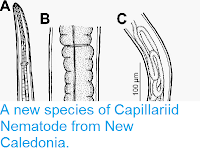The Nematode Caenorhabditis elegans is one of the most closely studied organism in modern biology, due to its small size and rapid reproduction, which makes it an ideal laboratory subject. The genome of Caenorhabditis elegans has been comprehensively mapped, and its development fully documented, allowing manipulation of its genetic code to be carefully studied, which has led to many discoveries with implications for other animals, including Humans. As such there has been a great deal of interest in discovering a sister species to Caenorhabditis elegans (that is to say a very closely related species, with a similar genetic history), with the species currently used as a sister in genetic studied, Caenorhabditis briggsae, being about as closely related to Caenorhabditis elegans as Humans are to Mice.
In a paper published in the journal Nature Communications on 10 August 2018, a team of scientists led by Natsumi Kanzaki of the Kansai Research Center of the Forestry and Forest Products Research Institute, Isheng Tsai of the Biodiversity Research Center at Academia Sinica, and Ryusei Tanaka and Vicky Hunt of the Faculty of Medicine at the University of Miyazaki, describe a sister species of Caenorhabditis elegans from Ishigaki Island, Japan.
The new species is named Caenorhabditis inopinata, where ‘inopinata’ means ‘surprising’ as the species was discovered unexpectedly by scientists who were not looking for a sister species to Caenorhabditis elegans, and only realised their discovery when they ran a genetic comparison of the new species to other members of the genus. Caenorhabditis inopinata was found living in Figs of the species Ficus septica, with the only members of the species found outside of these fruit being larvae attached to the abdomen of the Fig Wasp Ceratosolen bisulcatus, the pollinator of Ficus septica, making it highly likely that the Nematodes are carried from Fig-to-Fig during pollination. This is completely different to the life-cycle of Caenorhabditis elegans, which is a free-living Nematode found in soil and rotting plant matter. This different life-style is reflected in the anatomy of Caenorhabditis inopinata, which is longer and thinner than Caenorhabditis elegans, and has short stomatal flaps, a short tail and rounded appendage on the anterior cloacal lip in females and tongue-like postcloacal appendage in males.
Caenorhabditis inopinata biology compared with the sibling species Caenorhabditis elegans. (a) Differential interference contrast microscopic views of Caenorhabditis inopinata (adult female; bottom) with Caenorhabditis elegans (hermaphrodite; top). Scale bar: 100 μm. (b) Key morphological characters of Caenorhabditis inopinata. (a) Right lateral view of stomatal part in different focal planes showing dorsal tooth (left) and right subventral tooth (right) with arrow heads. (b) Ventral view of male tail. (c) Female tail in right lateral (left) and ventral (right) view showing phasmids in arrowheads. (d) Face view of stomatal part of adult. (e) Face view of stomatal part of dauer-like juvenile. (f) Left lateral view of male tail. (g) Ventral view of male cloacal opening. Scale bars: 20 μm for (a)–(c), 2 μm for (d)–(g). (c) Life cycle of Caenorhabditis inopinata. The nematodes multiply in fresh syconia of Ficus septica, which has a mutualistic association with the pollinating wasp Ceratosolen bisulcatus. When the syconia mature nematodes in the dauer form disperse to new young syconia using the wasps as a vector. Kanzaki et al. (2018).







